Killing to Multiply? The Consequences of US Drone Strikes in Pakistan
Labeled “the defining weapon of the War on Terror,” armed drones have become a hallmark of US military policy with applications in Afghanistan, Libya, Pakistan, Somalia, and Yemen. Despite the huge amounts of funds dedicated to the program and the repeated applause of the precision and efficacy of drone strikes from policy circles, evidence on the effectiveness of drone strikes as a counter-terrorism strategy is lacking. At the same time, narratives supporting the backlash of drone strikes also exist, stressing such missions can traumatize the civilian population, provoke anger towards the US, and facilitate recruitment efforts of terrorist organizations.
We study the consequences of US drone strikes on Pakistan. Since 2004, Pakistan has experienced 63 percent of all drone strikes directed at countries not at war with the US. The fact that no other US military intervention is possible in Pakistan (such as ground troops or conventional aircraft) allows us to isolate the effect of drone strikes from other military operations. However, analyzing the impact of drone strikes on terrorism is complicated because several factors simultaneously affect drone strikes and terrorism while reverse causality also remains a concern. For instance, the US may strike because terror attacks are imminent,
which would introduce an upward bias into estimates predicting subsequent terrorism with drone strikes. Because of these complications in identification, empirical studies to date have remained correlational (Smith and Walsh, 2013; Johnston and Sarbahi, 2016; Jaeger and Siddique, 2018; Mir and Moore, 2018).
We introduce an identification strategy to explore the effects of drone strikes in Pakistan on (i) the number of and deaths from terrorist attacks; and (ii) attitudes towards the US and major terrorist organizations. In particular, we leverage exogenous variation from wind conditions, hypothesizing that the likelihood of drone strikes decreases on days with stronger winds, everything else equal. Because wind conditions are not affected by drone strikes or terror attacks and present an exogenous variation, they help us identify the causal impact of drone strikes on terrorism.
Geographically, drone strikes in Pakistan are concentrated in the FATA region while terrorists can operate throughout the country, as visualized in Figure 1.
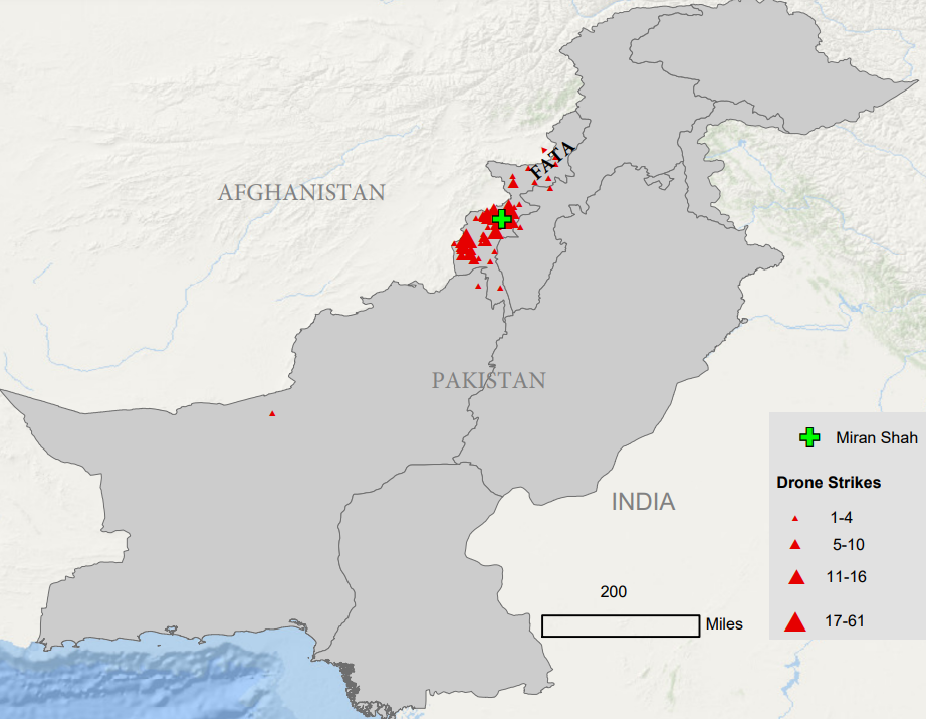
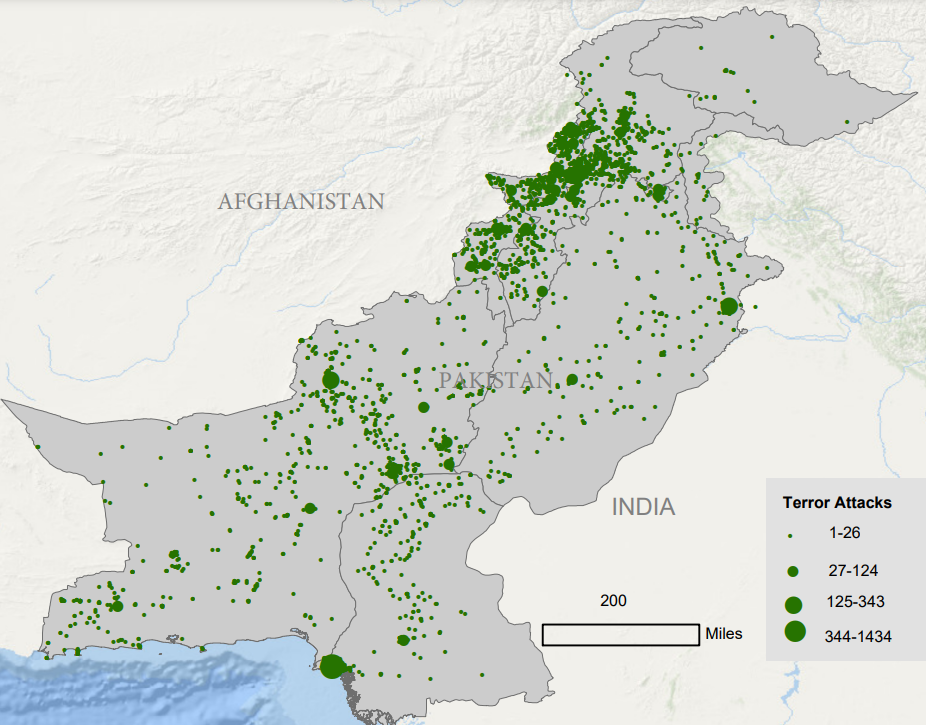
Figure 1: The location of drone strikes and terror attacks in Pakistan between 2006 and 2016. The green cross marks Miran Shah, where wind conditions are measured.
Methodology and Data
We hypothesize that the likelihood of drone strikes decreases on days with stronger winds, everything else equal. This hypothesis is built on the scientific literature suggesting drones to be sensitive to windy conditions. Accessing daily data from 2006 to 2016, we find fewer drone strikes on windy days. Specifically, we instrument the number of drone strikes with contemporaneous wind conditions in Miran Shah (see Figure 1), conditional on (i) preceding terror attacks, (ii) Pakistani military actions, (iii) fixed effects for days of the week and months of the year, (iv) temperature and precipitation levels, and (v) Ramadan days.
We derive daily data on drone strikes from January 1, 2006 until December 31, 2016 from the Bureau of Investigative Journalism. Data on terror attacks are derived from the Global Terrorism Database (GTD), while we access wind conditions from Meteoblue.
Empirical Findings: Terrorism
Our results imply drone strikes increase the number of terror attacks in subsequent weeks. The estimates from our analysis are able to explain 10.7 to 12.5 percent of all terror attacks throughout our sample period. We also explore the likely impacts for a period of 70 days after a drone strike. In case the sign of the derived coefficient switches at some point, it would indicate that, eventually, drone strikes may lead to a decrease in attacks. This could be the case if, for example, drone strikes are able to severely affect the operational capabilities of terror groups. However, as visualized in Figure 2 (top), we still derive a positive and statistically significant coefficient that remains stable in magnitude: Up to five attacks per day are suggested to happen solely because of a drone strike. In addition, deaths from terror attacks increase in the aftermath of drone strikes (see Figure 2, bottom panel), though we only identify a statistically meaningful relationship for six days after the initial drone strikes.
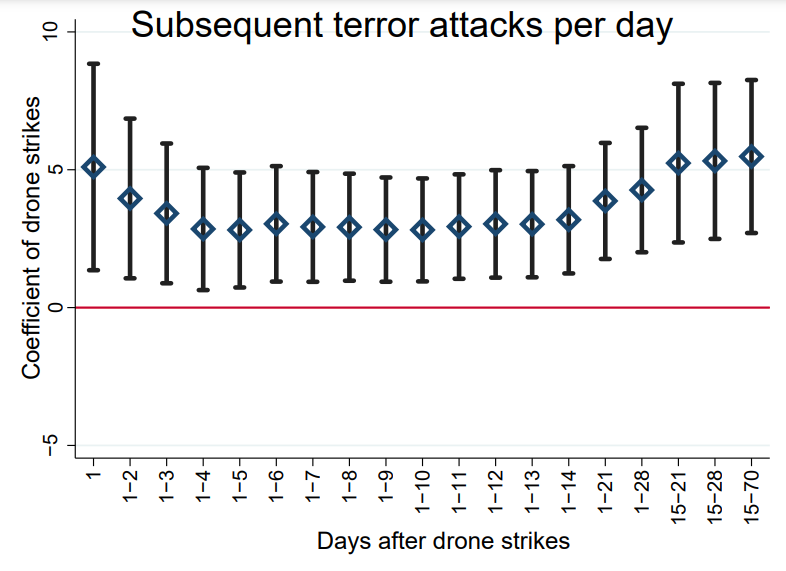
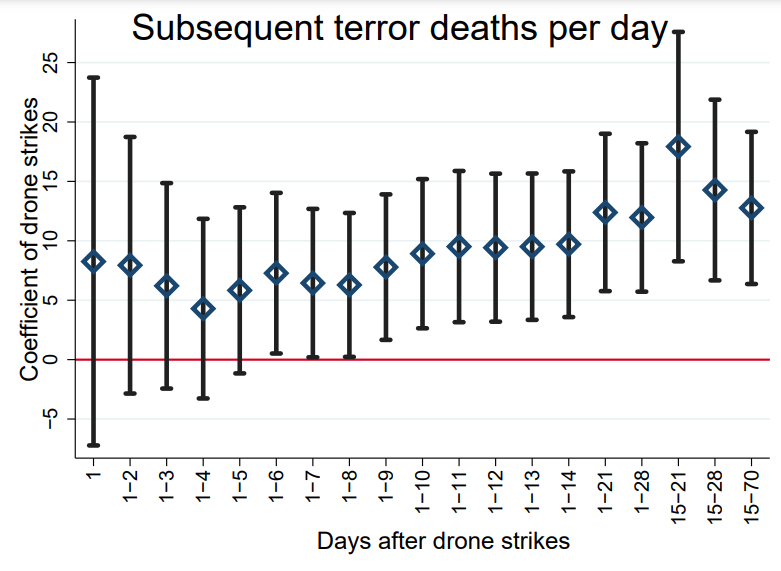
Figure 2: Predicting additional terror attacks (top) and deaths from terror attacks (bottom) per day after drone strikes. Each point represents the coefficient related to drone strikes in an IV regression, while the x-axis shows the number of days after drone strikes. Two-sided 95 percent confidence intervals are displayed.
Empirical Findings: Beliefs and Attitudes
Next, we aim to understand whether and, if so, how the general Pakistani populace responds to drone strikes. If drone strikes exclusively provoke existing terror group members, a hawkish military argument would suggest targeting all terrorists to eradicate terrorism; however, if non-members are affected, drone strikes may affect popular opinion and potentially widen the public's acceptance of militants. For example, the blowback hypothesis suggests military intervention can facilitate recruitment efforts of and financial support for terrorist organizations.
First, we analyze the emotional content of articles discussing drones and the US in the leading English-language newspaper in Pakistan, The News International (TNI). We find a polarized response to drone strikes, as negative emotions and anger, as well as positive emotional content in drone-related articles, increase (see Figure 3, top panel). Further regressions show negative emotions and anger towards the US increase because of drone strikes, but these conclusions only emerge for articles that also discuss drone strikes (see Figure 3, bottom panel). The results prevail when studying sentiment in the exact sentences that mention the US when analyzing Top Stories only and also when we extend our analysis to the subsequent two weeks after drone strikes.
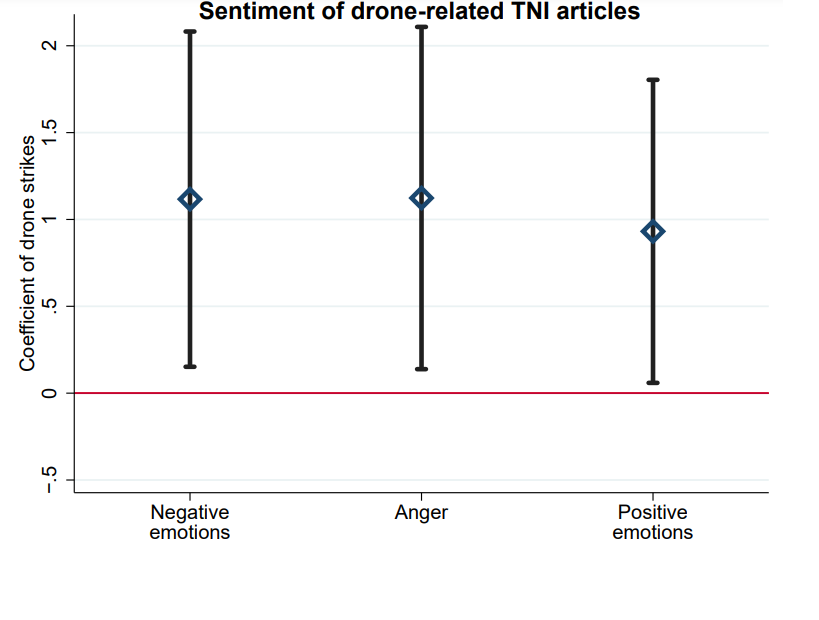
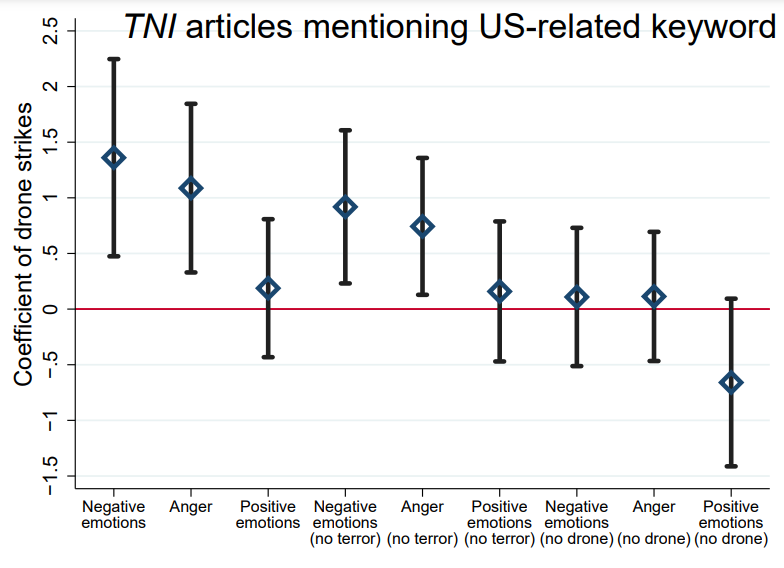
Figure 3: IV results from predicting emotional content of drone-related articles (top) and predicting emotional content of articles mentioning a US-related keyword (bottom) in the subsequent seven days after drone strikes. Each point represents the coefficient related to drone strikes in an IV regression.
Second, we explore anti-US protests documented in the Global Data on Events, Location, and Tone (GDELT) database. Our findings indicate a rise in the number and likelihood of anti-US protests, as visualized in Figure 4 (top). In terms of magnitude, one drone strike raises anti-US protests by 2-3 standard deviations in the following days and weeks, signaling a substantial increase in public expressions of disapproval with the US.
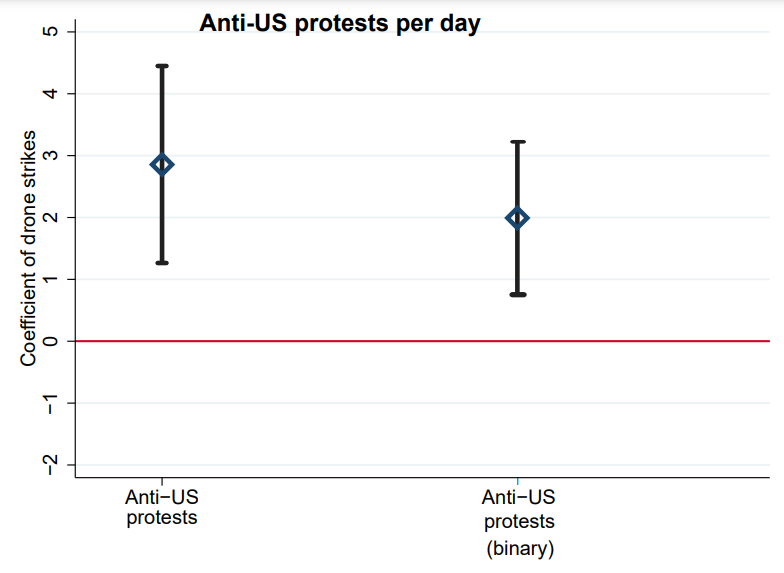
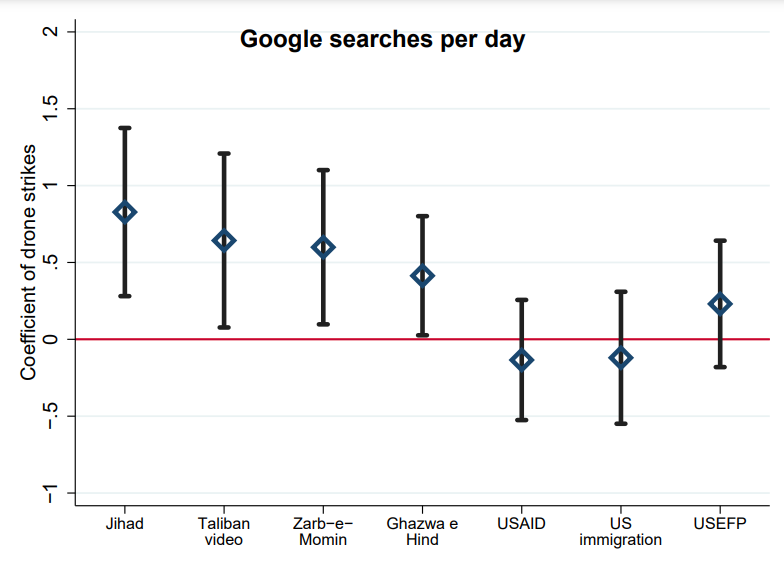
Figure 4: IV results from predicting anti-US protests (top) and Google searches for various topics (bottom) in the subsequent 14 days. Each point represents the coefficient related to drone strikes in an IV regression.
Third, to explore the day-to-day prominence of radical concepts and groups, we study Google searches for the terms jihad, Taliban video, Zarb-e-Momin/Zarb-i-Momin (a weekly Pakistani magazine expressing radical beliefs), and Ghazwa e Hind (the Battle for the Indian subcontinent, mentioned frequently in terrorist propaganda literature). Our analysis consistently identifies elevated search frequencies because of drone strikes (see Figure 4, bottom panel). However, online searches for terms capturing interest in US-related topics (USAID – the United States Agency for International Development; US immigration; and USEFP – the US Educational Foundation in Pakistan) does not change. Taken together, these results suggest an increase in anti-US sentiment and radical interests among the general Pakistani populace because of drone strikes.
Conclusion
Overall, our empirical results imply drone strikes cause terror attacks in Pakistan. We also find that drone strikes lead to growing anti-US sentiment and increasing interest in radical topics in the Pakistani population. These attributes of drone strikes stand in stark contrast to the goals advocated by the War on Terror and rather suggest support for the blowback hypothesis. As the US military continues to expand its drone program, we hope our research provides useful insights into the underlying consequences, as well as starting points for further research.
Rafat Mahmood is a Postdoctoral Fellow in Economics at New York University, Abu Dhabi
Michael Jetter works at the University of Western Australia in Perth
Mahbub ul Haq Research Centre at LUMS
Postal Address
LUMS
Sector U, DHA
Lahore Cantt, 54792, Pakistan
Office Hours
Mon. to Fri., 8:30 a.m. to 5:00 p.m.





